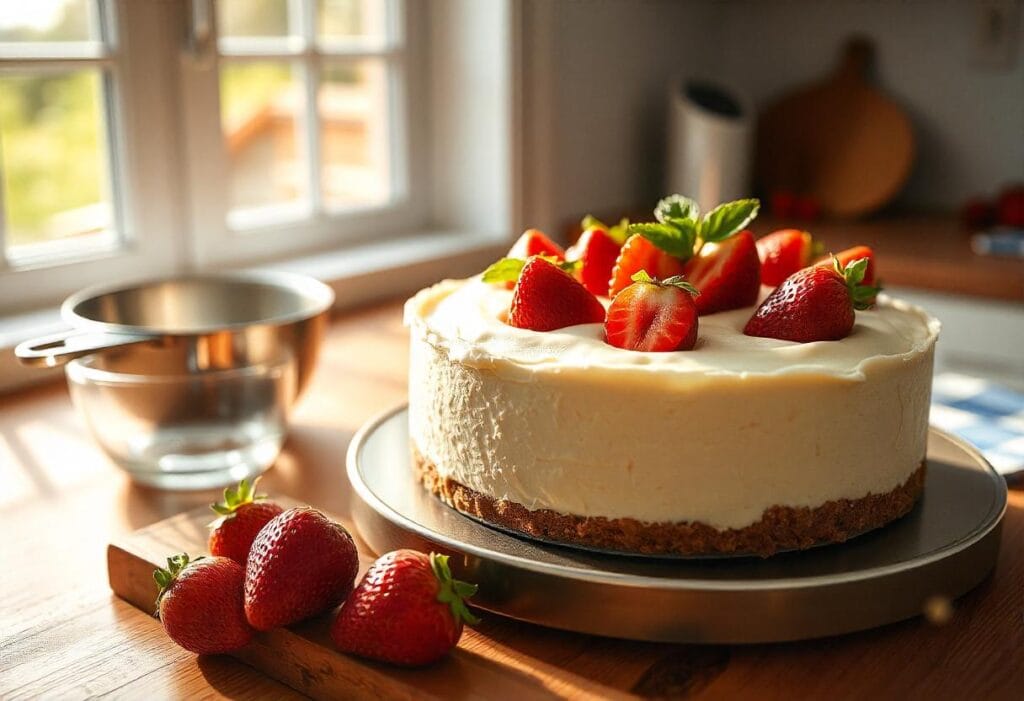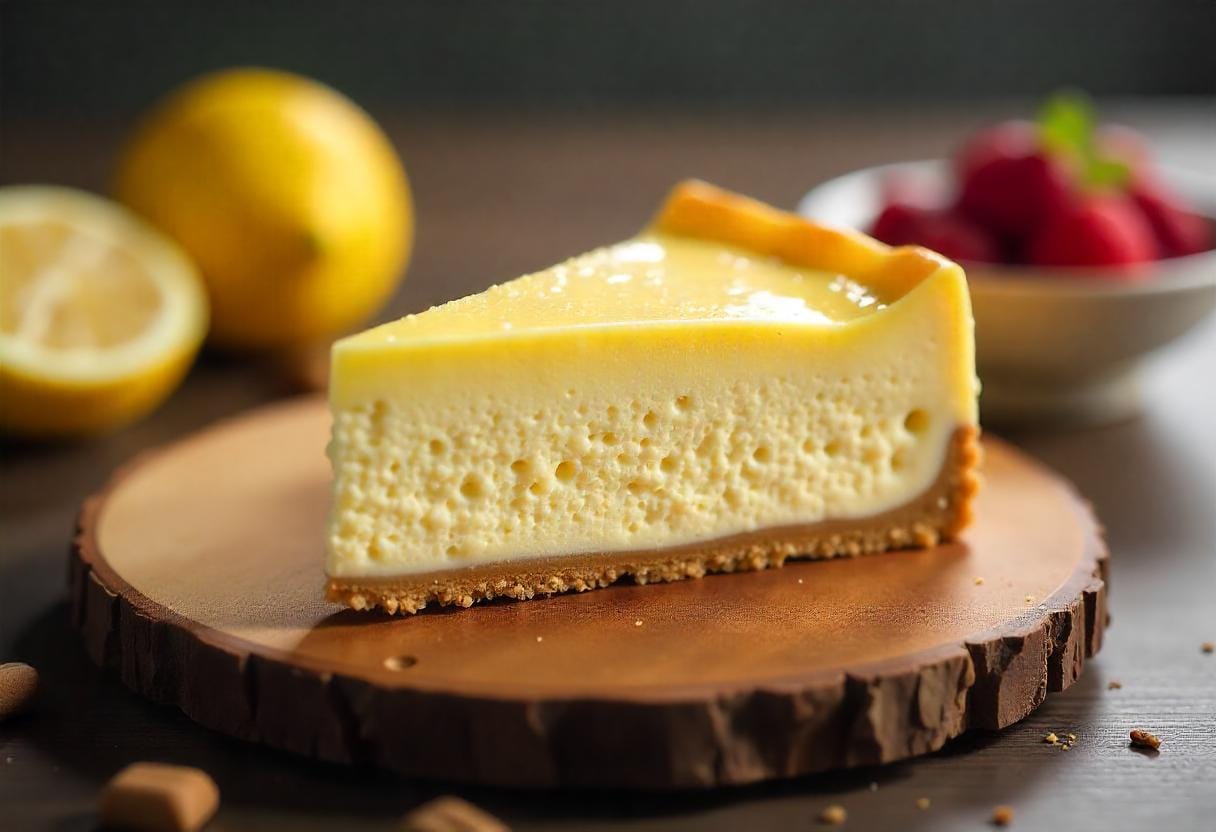Cheesecake – a dessert loved for its rich, creamy texture. But what’s the secret behind its perfect consistency? The answer lies in the thickening agent in cheesecake. These magical ingredients ensure your cheesecake is firm yet smooth, creating that irresistible bite we all adore. Let’s uncover the secrets to achieving cheesecake perfection!
Introduction to Cheesecake Thickening Agents
Imagine biting into a cheesecake that’s runny or crumbly – not exactly appetizing, right? The key to that dreamy, firm-yet-soft consistency is the thickening agent. Whether you’re a fan of baked or no-bake cheesecakes, these ingredients do the heavy lifting to create that perfect texture.
Why should you care? Well, understanding thickening agents isn’t just for pastry chefs. It’s your golden ticket to mastering cheesecake, impressing friends, and avoiding kitchen disasters.
“The right thickening agent can make or break your cheesecake. It’s the unsung hero of this beloved dessert!”
Types of Cheesecake: Baked vs. No-Bake
Let’s settle this first: are you a baked cheesecake enthusiast, or do you prefer the no-bake variety? Each has its charm, but they rely on different thickening methods.
The Role of Thickening Agents in Baked Cheesecakes
Baked cheesecakes use heat to set the thickening agents. Eggs are the stars here. When baked, they coagulate, binding everything together. Think of them as the glue holding your cheesecake in perfect harmony.
Thickening Needs for No-Bake Cheesecakes
No-bake cheesecakes? They skip the oven entirely. Instead, they lean agar-agar, or even whipped cream for stability. These agents give no-bake cheesecakes their firm, sliceable structure without the need for heat.

Top Thickening Agents for Cheesecake
Now that we know the types, let’s break down the MVPs (Most Valuable Players) in cheesecake thickening.
1. Cream Cheese: The Foundation of Cheesecake Texture
Cream cheese is the backbone of almost every cheesecake. Its rich, velvety texture is what makes cheesecake, well, a cheesecake. But it’s not just about taste – cream cheese also adds heft and stability to the mix.
2. Eggs: The Essential Thickener for Baked Cheesecake
Eggs are like the secret weapon for baked cheesecakes. They thicken as they cook, creating a smooth, dense texture. But here’s the catch: overmixing can lead to cracks (the horror!).
Nutrition Facts Table (Per Slice)
| Nutrient | Amount |
|---|---|
| Calories | 320 kcal |
| Protein | 6 g |
| Fat | 20 g |
| Carbohydrates | 28 g |
| Sugar | 18 g |
| Sodium | 150 mg |
| Calcium | 8% DV |
Common Problems with Cheesecake Texture
Even with the best thickening agents, things can go wrong. Let’s tackle the most common issues and how to fix them.
Why Does My Cheesecake Crack?
Cracks in cheesecake are like wrinkles in a perfect outfit – annoying and avoidable. The culprit? Overmixing or baking at too high a temperature. To prevent this, bake in a water bath and avoid peeking while it cooks.
How to Fix a Runny Cheesecake
A runny cheesecake means the thickening agent didn’t do its job. Maybe you skipped an ingredient (oops!) or didn’t give it enough time to set. For no-bake versions, let the cheesecake chill overnight – patience is your best friend.
How to Use Thickening Agents in Cheesecake
So, how exactly do you use these magical ingredients to achieve that perfect cheesecake texture? Whether you’re working with eggs, cream cheese, or agar-agar, there are specific techniques to get it right.
Measuring and Mixing for Perfect Consistency
Precision is everything in baking. Use measuring cups and a digital scale to ensure your ratios are spot-on. For baked cheesecakes, beat the cream cheese until smooth before adding eggs to avoid lumps.
“Think of cheesecake-making as painting a masterpiece. Each ingredient is a brushstroke contributing to the final masterpiece.”

Tips for Avoiding Over-Thickened or Under-Thickened Cheesecake
Over-thickened cheesecakes can feel like biting into a brick, while under-thickened ones resemble pudding. The secret? Follow the recipe closely, avoid overmixing, and respect chilling or baking times.
Expert Tips for Choosing the Right Thickening Agent
Choosing the right thickening agent isn’t just about following a recipe – it’s about understanding what works best for your cheesecake style and preferences.
Matching the Thickener to Your Recipe Type
- Baked Cheesecakes: Stick with eggs and cream cheese for that classic dense texture.
- No-Bake Cheesecakes: Use agar-agar for a firm, sliceable consistency.
- Light Cheesecakes: Opt for whipped cream or yogurt to keep things airy.
Adapting Recipes for Dietary Restrictions
Got guests who are vegetarian, gluten-free, or keto? No problem! Agar-agar replaces gelatin, almond flour swaps for graham crackers, and cream cheese comes in low-fat or vegan varieties.
The Science Behind Cheesecake Thickening Agents
Let’s geek out for a moment. What’s actually happening when you use thickening agents in cheesecake?
How Proteins and Starches Work Together
Eggs and cream cheese contain proteins that bond when heated, creating that firm texture in baked cheesecakes. Starches like cornstarch or flour absorb moisture, adding stability.
Understanding Heat and Setting Processes
For baked cheesecakes, heat is the magic wand. It activates the eggs and proteins, transforming the batter into a solid form.
The Role of Fat Content in Cheesecake Thickness
Did you know that the fat content in your ingredients also plays a significant role in achieving the perfect cheesecake texture? It’s not just about the thickening agents—it’s about how they interact with fats like cream cheese, sour cream, and butter.
Why Fat Matters in Cheesecake
Fat contributes to the rich, smooth texture of cheesecake. It provides the body and creaminess that makes every bite feel indulgent. The higher the fat content, the denser and more luxurious the cheesecake will be.
Choosing the Right Ingredients
When buying cream cheese or sour cream for your cheesecake, always opt for full-fat versions unless the recipe specifically calls for a lighter alternative. Low-fat or fat-free options can result in a watery batter, compromising both texture and taste.
Common Cheesecake Mistakes and How to Avoid Them
Cheesecake might seem intimidating, but with a few tips, you can avoid the most common pitfalls. Let’s troubleshoot some kitchen mishaps!
Problem: Cheesecake is Too Soft or Runny
If your cheesecake isn’t setting properly, it’s likely due to one of these reasons:
- Not Enough Thickening Agent: Ensure you use the correct amount of eggs, or cornstarch.
- Insufficient Chilling Time: For no-bake cheesecakes, let it chill for at least 6-8 hours.
- Ingredient Substitutions: Replacing full-fat cream cheese with a lighter version can lead to a softer texture.
Solution
To fix a runny cheesecake, you can try freezing it for a firmer texture. For baked versions, ensure the center jiggles slightly but is not liquid when you remove it from the oven.
Problem: Cheesecake Cracks During Baking
Cracks are the bane of baked cheesecakes, but they’re not the end of the world. They’re often caused by overmixing the batter or baking at too high a temperature.
Solution
- Use a Water Bath: Wrap the cheesecake pan in foil and place it in a larger pan filled with water. This helps maintain even baking temperatures.
- Avoid Overmixing: Mix the batter just until the ingredients are combined to prevent excess air.
- Cool Gradually: Let the cheesecake cool in the oven with the door slightly open for about an hour before transferring it to the fridge.
How Cheesecake Differs Across Cultures
Cheesecake isn’t just an American classic. It has variations all around the world, each with its unique thickening techniques and flavors.
Japanese Cheesecake
Fluffy and light, Japanese cheesecake uses whipped egg whites to achieve a soufflé-like texture. Unlike traditional dense cheesecakes, it’s airy and almost melts in your mouth.
New York Cheesecake
The quintessential cheesecake! New York-style cheesecake is dense and creamy, thanks to a generous amount of cream cheese and eggs. A hint of lemon juice or zest often brightens its flavor.
Italian Cheesecake
Italian cheesecakes use ricotta or mascarpone instead of cream cheese. The result is lighter, with a slightly grainy texture from the ricotta. It’s a must-try for those seeking a new twist on the classic.
“Cheesecake has evolved into a universal language of dessert. From Japan to Italy, each culture adds its unique spin to this beloved treat.”
Layered Cheesecakes: An Artistic Take
Looking to impress? Layered cheesecakes combine multiple flavors and textures for a show-stopping dessert. For example:
- Chocolate and Vanilla Swirl Cheesecake: A mix of chocolate and vanilla layers, creating a visual masterpiece.
- Berry-Topped Cheesecake: Layers of cheesecake with fresh fruit or jam for a burst of color and flavor.
Pro Tip: When layering, chill each layer for 15-20 minutes before adding the next to ensure clean lines.
Cheesecake Toppings: Elevate Your Dessert Game
The right topping can take your cheesecake from delicious to divine. Here are some ideas:
- Fruit Compote: Fresh berries, sugar, and lemon juice cooked into a sweet sauce.
- Whipped Cream: A dollop of lightly sweetened whipped cream adds elegance.
- Chocolate Ganache: Rich and glossy, perfect for chocoholics.
Cheesecake Variations for Every Diet
Want to enjoy cheesecake while sticking to your dietary preferences? Here’s how to adapt the classic recipe:
Keto Cheesecake
Replace sugar with erythritol or stevia and use almond flour for the crust. Full-fat cream cheese keeps it rich and creamy without the carbs.
Vegan Cheesecake
Swap cream cheese for cashew cream or coconut cream. Agar-agar is an excellent plant-based alternative to gelatin.
Gluten-Free Cheesecake
Use gluten-free graham crackers or almond flour for the crust. Ensure all other ingredients are certified gluten-free.
Cheesecake Storage Tips: Keeping It Fresh
Cheesecake is delicate and needs proper storage to maintain its flavor and texture.
Short-Term Storage
Cover the cheesecake with plastic wrap and store it in the refrigerator for up to 5 days.
Long-Term Storage
For longer storage, freeze individual slices wrapped tightly in plastic wrap and foil. They’ll last up to 3 months in the freezer.
“A frozen slice of cheesecake is like a time capsule of deliciousness, ready to be enjoyed whenever you crave it!”
Creative Cheesecake Ideas to Try at Home
Feeling adventurous? Here are some innovative twists on the classic cheesecake:
- Cheesecake-Stuffed Cupcakes: Miniature bites of cheesecake baked into cupcake form.
- Savory Cheesecake: Yes, you read that right! Cheesecake made with goat cheese and herbs, perfect as an appetizer.
- No-Bake Cheesecake Bars: Quick and easy, these bars are perfect for a crowd.
Final Thoughts: The Art of Perfect Cheesecake
Cheesecake is more than just a dessert – it’s an experience. From the silky texture to the rich flavors, every bite is a testament to the power of well-chosen thickening agents. Whether you’re a traditionalist sticking to New York cheesecake or an experimenter trying vegan options, the key is understanding how ingredients work together.
So, the next time you whip up a cheesecake, remember: you’re not just baking. You’re creating a masterpiece. And who wouldn’t want to be the Picasso of cheesecakes? 🎨🍰
FAQs About Cheesecake Thickening Agents
Can I Make Cheesecake Without a Thickening Agent?
Technically, no. Cheesecake relies on a thickening agent to set. However, you can experiment with naturally thick ingredients like mashed bananas or pureed cashews for a unique twist.
Why Does My Cheesecake Collapse After Baking?
This happens when air gets trapped in the batter from overmixing. Next time, mix gently, and let the cheesecake cool gradually to avoid a dramatic collapse.
Cheesecake Ingredients Table (Classic Baked Cheesecake)
| Ingredient | Quantity |
|---|---|
| Cream Cheese | 16 oz (450 g) |
| Granulated Sugar | 3/4 cup (150 g) |
| Eggs | 3 large |
| Sour Cream | 1 cup (240 ml) |
| Vanilla Extract | 1 tsp |
| Graham Cracker Crust | 1 pre-made or homemade |
Conclusion: Mastering the Art of Cheesecake Thickening
By now, you’re practically a cheesecake expert! You’ve learned the ins and outs of thickening agents, from cream cheese and eggs to agar-agar. Whether you’re crafting a baked cheesecake for a family dinner or a no-bake version for a summer party, these tools will help you nail it every time.
Remember, baking is part science and part art. Play around with these tips, adapt recipes to your liking, and most importantly, enjoy the process. After all, the best cheesecake is the one shared with loved ones. 🍰💖

